Stakeholder Analysis Report: Tesla Motors and Industry Comparison
VerifiedAdded on 2022/12/26
|13
|3223
|72
Report
AI Summary
This report conducts a stakeholder analysis of Tesla, examining both internal and external stakeholders. It identifies key functional areas, including sustainable growth and technological advancements, and details the roles of stakeholders like employees, shareholders, customers, and the government, using tools like PESTLE analysis. The report explores the interests of each stakeholder group, highlighting potential conflicts and the levels of influence they wield. A stakeholder matrix is created to visualize these relationships. Furthermore, the report compares Tesla's manufacturing model with the hospitality industry, specifically Marriott International, contrasting tangibility, production, and stakeholder dynamics. The analysis emphasizes the importance of stakeholder management for business success, concluding with a discussion on ethical considerations and the impact of stakeholder interests on Tesla's strategies and operations.
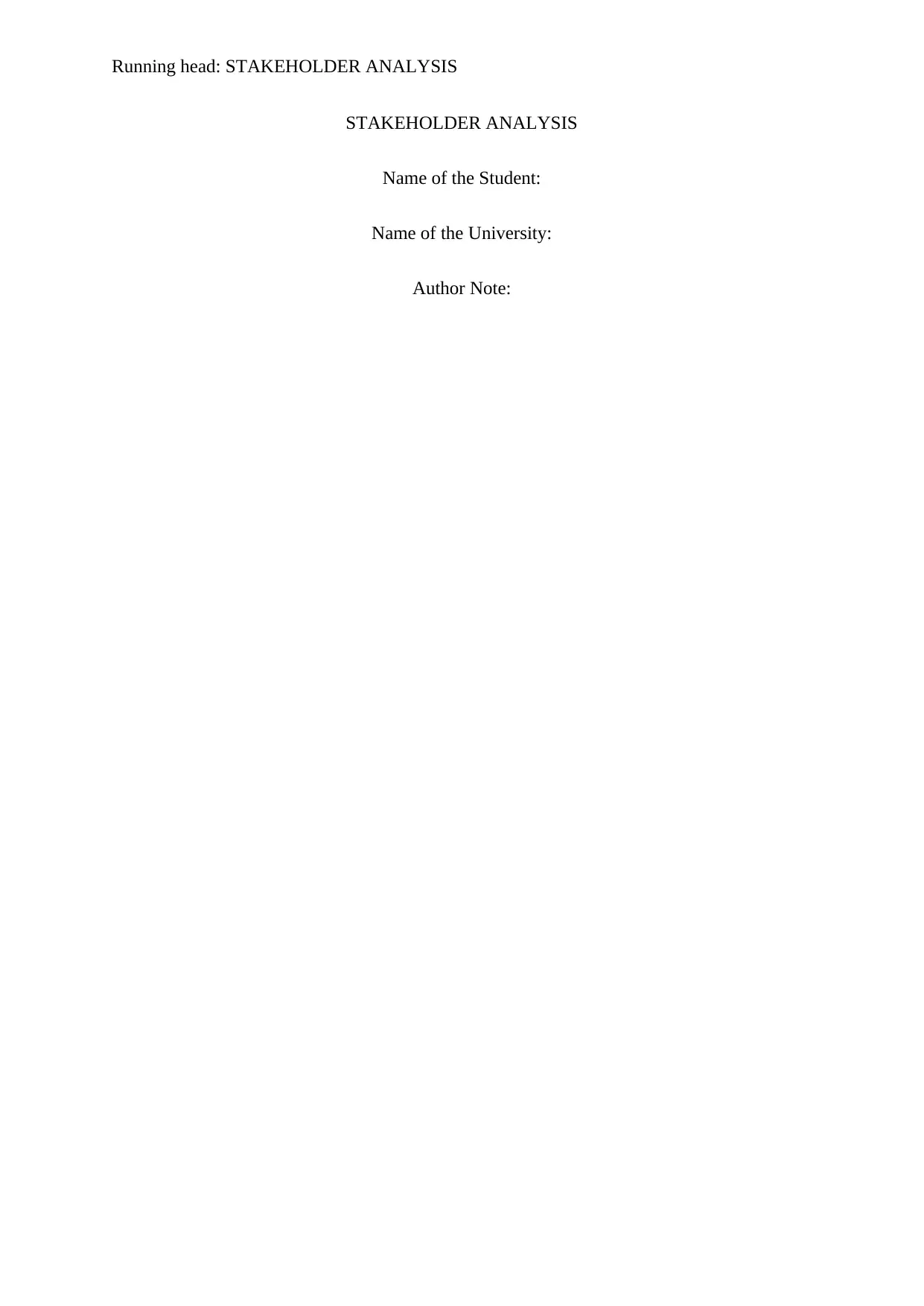
Running head: STAKEHOLDER ANALYSIS
STAKEHOLDER ANALYSIS
Name of the Student:
Name of the University:
Author Note:
STAKEHOLDER ANALYSIS
Name of the Student:
Name of the University:
Author Note:
Paraphrase This Document
Need a fresh take? Get an instant paraphrase of this document with our AI Paraphraser
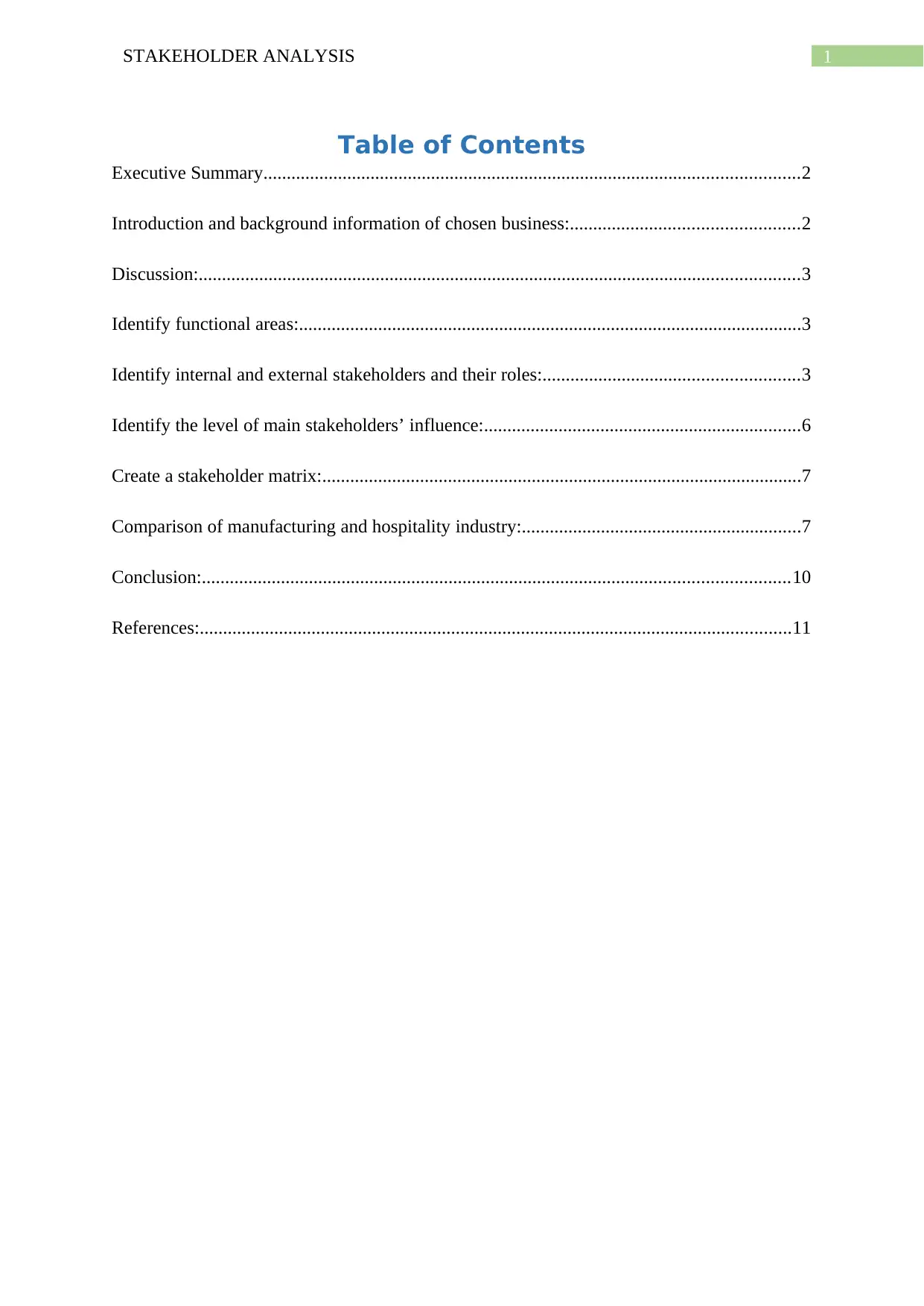
1STAKEHOLDER ANALYSIS
Table of Contents
Executive Summary...................................................................................................................2
Introduction and background information of chosen business:.................................................2
Discussion:.................................................................................................................................3
Identify functional areas:............................................................................................................3
Identify internal and external stakeholders and their roles:.......................................................3
Identify the level of main stakeholders’ influence:....................................................................6
Create a stakeholder matrix:.......................................................................................................7
Comparison of manufacturing and hospitality industry:............................................................7
Conclusion:..............................................................................................................................10
References:...............................................................................................................................11
Table of Contents
Executive Summary...................................................................................................................2
Introduction and background information of chosen business:.................................................2
Discussion:.................................................................................................................................3
Identify functional areas:............................................................................................................3
Identify internal and external stakeholders and their roles:.......................................................3
Identify the level of main stakeholders’ influence:....................................................................6
Create a stakeholder matrix:.......................................................................................................7
Comparison of manufacturing and hospitality industry:............................................................7
Conclusion:..............................................................................................................................10
References:...............................................................................................................................11
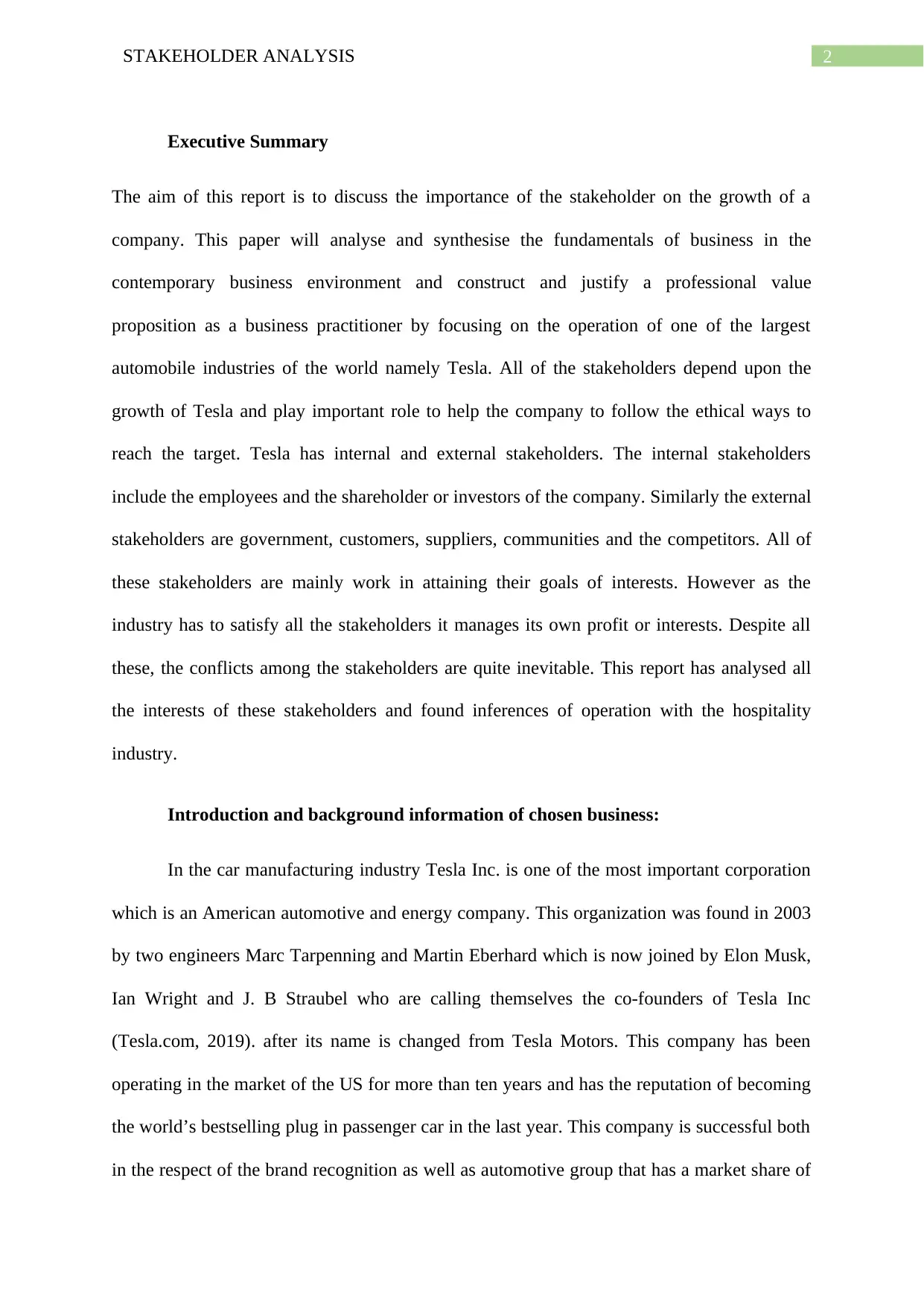
2STAKEHOLDER ANALYSIS
Executive Summary
The aim of this report is to discuss the importance of the stakeholder on the growth of a
company. This paper will analyse and synthesise the fundamentals of business in the
contemporary business environment and construct and justify a professional value
proposition as a business practitioner by focusing on the operation of one of the largest
automobile industries of the world namely Tesla. All of the stakeholders depend upon the
growth of Tesla and play important role to help the company to follow the ethical ways to
reach the target. Tesla has internal and external stakeholders. The internal stakeholders
include the employees and the shareholder or investors of the company. Similarly the external
stakeholders are government, customers, suppliers, communities and the competitors. All of
these stakeholders are mainly work in attaining their goals of interests. However as the
industry has to satisfy all the stakeholders it manages its own profit or interests. Despite all
these, the conflicts among the stakeholders are quite inevitable. This report has analysed all
the interests of these stakeholders and found inferences of operation with the hospitality
industry.
Introduction and background information of chosen business:
In the car manufacturing industry Tesla Inc. is one of the most important corporation
which is an American automotive and energy company. This organization was found in 2003
by two engineers Marc Tarpenning and Martin Eberhard which is now joined by Elon Musk,
Ian Wright and J. B Straubel who are calling themselves the co-founders of Tesla Inc
(Tesla.com, 2019). after its name is changed from Tesla Motors. This company has been
operating in the market of the US for more than ten years and has the reputation of becoming
the world’s bestselling plug in passenger car in the last year. This company is successful both
in the respect of the brand recognition as well as automotive group that has a market share of
Executive Summary
The aim of this report is to discuss the importance of the stakeholder on the growth of a
company. This paper will analyse and synthesise the fundamentals of business in the
contemporary business environment and construct and justify a professional value
proposition as a business practitioner by focusing on the operation of one of the largest
automobile industries of the world namely Tesla. All of the stakeholders depend upon the
growth of Tesla and play important role to help the company to follow the ethical ways to
reach the target. Tesla has internal and external stakeholders. The internal stakeholders
include the employees and the shareholder or investors of the company. Similarly the external
stakeholders are government, customers, suppliers, communities and the competitors. All of
these stakeholders are mainly work in attaining their goals of interests. However as the
industry has to satisfy all the stakeholders it manages its own profit or interests. Despite all
these, the conflicts among the stakeholders are quite inevitable. This report has analysed all
the interests of these stakeholders and found inferences of operation with the hospitality
industry.
Introduction and background information of chosen business:
In the car manufacturing industry Tesla Inc. is one of the most important corporation
which is an American automotive and energy company. This organization was found in 2003
by two engineers Marc Tarpenning and Martin Eberhard which is now joined by Elon Musk,
Ian Wright and J. B Straubel who are calling themselves the co-founders of Tesla Inc
(Tesla.com, 2019). after its name is changed from Tesla Motors. This company has been
operating in the market of the US for more than ten years and has the reputation of becoming
the world’s bestselling plug in passenger car in the last year. This company is successful both
in the respect of the brand recognition as well as automotive group that has a market share of
⊘ This is a preview!⊘
Do you want full access?
Subscribe today to unlock all pages.

Trusted by 1+ million students worldwide
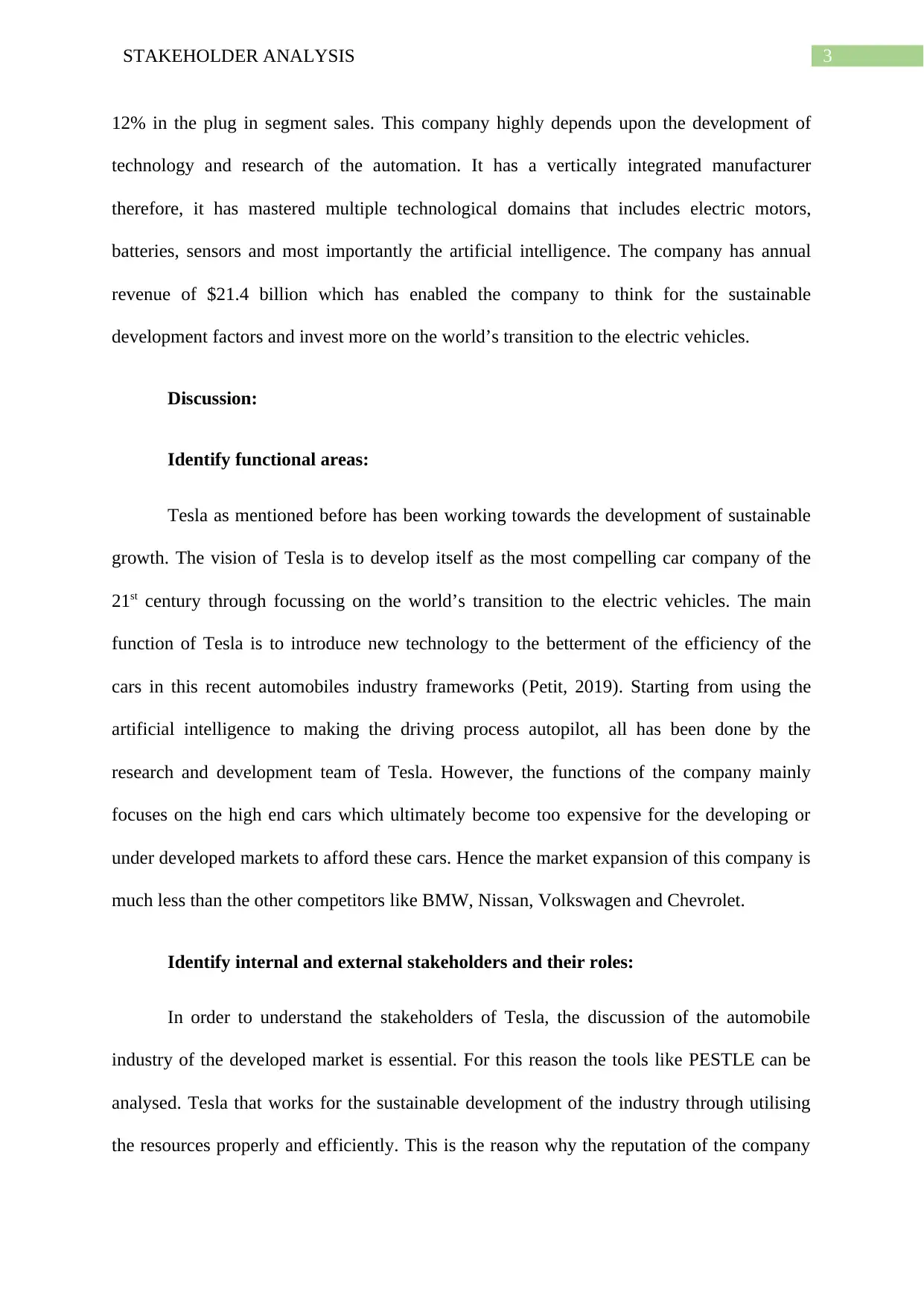
3STAKEHOLDER ANALYSIS
12% in the plug in segment sales. This company highly depends upon the development of
technology and research of the automation. It has a vertically integrated manufacturer
therefore, it has mastered multiple technological domains that includes electric motors,
batteries, sensors and most importantly the artificial intelligence. The company has annual
revenue of $21.4 billion which has enabled the company to think for the sustainable
development factors and invest more on the world’s transition to the electric vehicles.
Discussion:
Identify functional areas:
Tesla as mentioned before has been working towards the development of sustainable
growth. The vision of Tesla is to develop itself as the most compelling car company of the
21st century through focussing on the world’s transition to the electric vehicles. The main
function of Tesla is to introduce new technology to the betterment of the efficiency of the
cars in this recent automobiles industry frameworks (Petit, 2019). Starting from using the
artificial intelligence to making the driving process autopilot, all has been done by the
research and development team of Tesla. However, the functions of the company mainly
focuses on the high end cars which ultimately become too expensive for the developing or
under developed markets to afford these cars. Hence the market expansion of this company is
much less than the other competitors like BMW, Nissan, Volkswagen and Chevrolet.
Identify internal and external stakeholders and their roles:
In order to understand the stakeholders of Tesla, the discussion of the automobile
industry of the developed market is essential. For this reason the tools like PESTLE can be
analysed. Tesla that works for the sustainable development of the industry through utilising
the resources properly and efficiently. This is the reason why the reputation of the company
12% in the plug in segment sales. This company highly depends upon the development of
technology and research of the automation. It has a vertically integrated manufacturer
therefore, it has mastered multiple technological domains that includes electric motors,
batteries, sensors and most importantly the artificial intelligence. The company has annual
revenue of $21.4 billion which has enabled the company to think for the sustainable
development factors and invest more on the world’s transition to the electric vehicles.
Discussion:
Identify functional areas:
Tesla as mentioned before has been working towards the development of sustainable
growth. The vision of Tesla is to develop itself as the most compelling car company of the
21st century through focussing on the world’s transition to the electric vehicles. The main
function of Tesla is to introduce new technology to the betterment of the efficiency of the
cars in this recent automobiles industry frameworks (Petit, 2019). Starting from using the
artificial intelligence to making the driving process autopilot, all has been done by the
research and development team of Tesla. However, the functions of the company mainly
focuses on the high end cars which ultimately become too expensive for the developing or
under developed markets to afford these cars. Hence the market expansion of this company is
much less than the other competitors like BMW, Nissan, Volkswagen and Chevrolet.
Identify internal and external stakeholders and their roles:
In order to understand the stakeholders of Tesla, the discussion of the automobile
industry of the developed market is essential. For this reason the tools like PESTLE can be
analysed. Tesla that works for the sustainable development of the industry through utilising
the resources properly and efficiently. This is the reason why the reputation of the company
Paraphrase This Document
Need a fresh take? Get an instant paraphrase of this document with our AI Paraphraser
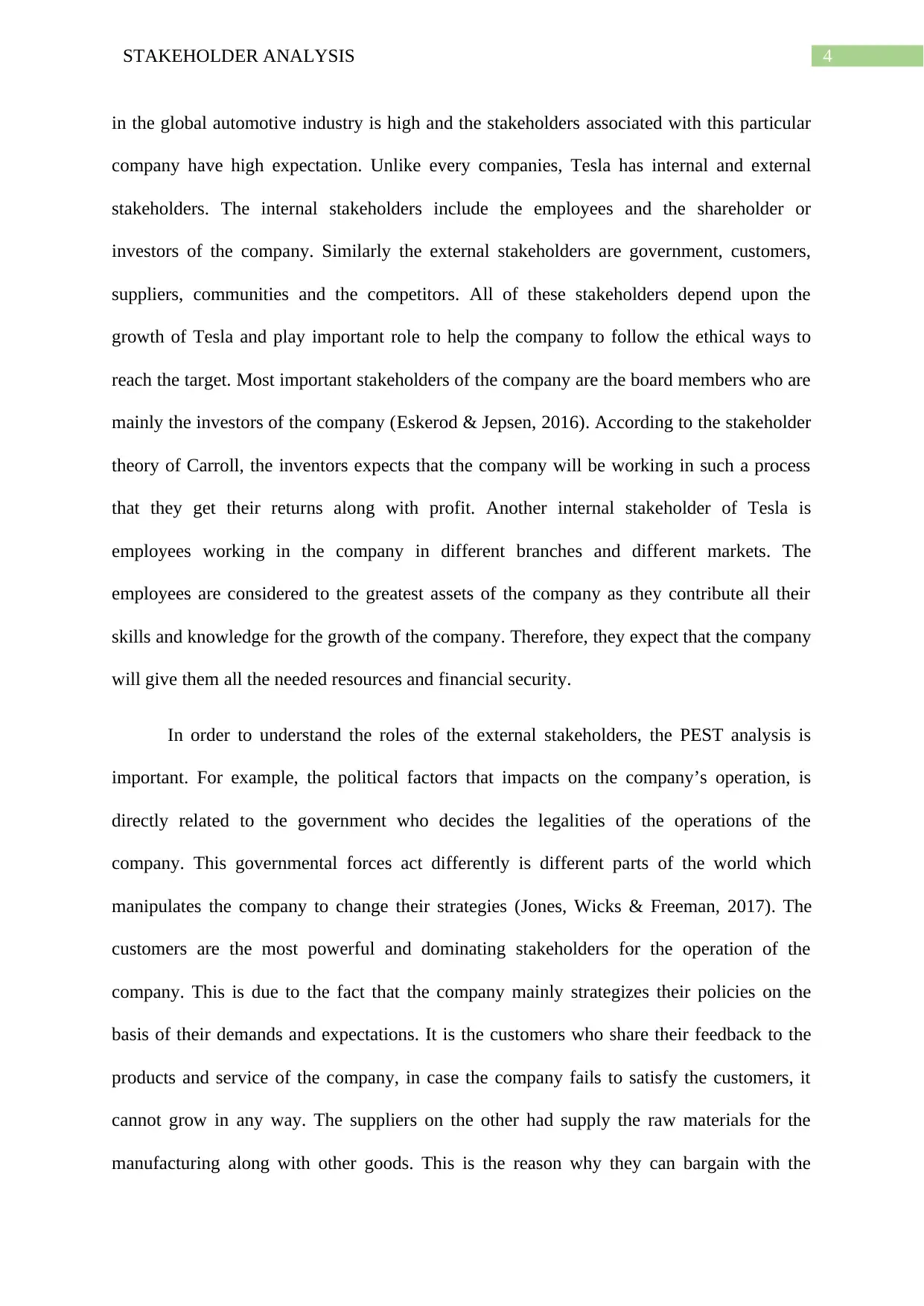
4STAKEHOLDER ANALYSIS
in the global automotive industry is high and the stakeholders associated with this particular
company have high expectation. Unlike every companies, Tesla has internal and external
stakeholders. The internal stakeholders include the employees and the shareholder or
investors of the company. Similarly the external stakeholders are government, customers,
suppliers, communities and the competitors. All of these stakeholders depend upon the
growth of Tesla and play important role to help the company to follow the ethical ways to
reach the target. Most important stakeholders of the company are the board members who are
mainly the investors of the company (Eskerod & Jepsen, 2016). According to the stakeholder
theory of Carroll, the inventors expects that the company will be working in such a process
that they get their returns along with profit. Another internal stakeholder of Tesla is
employees working in the company in different branches and different markets. The
employees are considered to the greatest assets of the company as they contribute all their
skills and knowledge for the growth of the company. Therefore, they expect that the company
will give them all the needed resources and financial security.
In order to understand the roles of the external stakeholders, the PEST analysis is
important. For example, the political factors that impacts on the company’s operation, is
directly related to the government who decides the legalities of the operations of the
company. This governmental forces act differently is different parts of the world which
manipulates the company to change their strategies (Jones, Wicks & Freeman, 2017). The
customers are the most powerful and dominating stakeholders for the operation of the
company. This is due to the fact that the company mainly strategizes their policies on the
basis of their demands and expectations. It is the customers who share their feedback to the
products and service of the company, in case the company fails to satisfy the customers, it
cannot grow in any way. The suppliers on the other had supply the raw materials for the
manufacturing along with other goods. This is the reason why they can bargain with the
in the global automotive industry is high and the stakeholders associated with this particular
company have high expectation. Unlike every companies, Tesla has internal and external
stakeholders. The internal stakeholders include the employees and the shareholder or
investors of the company. Similarly the external stakeholders are government, customers,
suppliers, communities and the competitors. All of these stakeholders depend upon the
growth of Tesla and play important role to help the company to follow the ethical ways to
reach the target. Most important stakeholders of the company are the board members who are
mainly the investors of the company (Eskerod & Jepsen, 2016). According to the stakeholder
theory of Carroll, the inventors expects that the company will be working in such a process
that they get their returns along with profit. Another internal stakeholder of Tesla is
employees working in the company in different branches and different markets. The
employees are considered to the greatest assets of the company as they contribute all their
skills and knowledge for the growth of the company. Therefore, they expect that the company
will give them all the needed resources and financial security.
In order to understand the roles of the external stakeholders, the PEST analysis is
important. For example, the political factors that impacts on the company’s operation, is
directly related to the government who decides the legalities of the operations of the
company. This governmental forces act differently is different parts of the world which
manipulates the company to change their strategies (Jones, Wicks & Freeman, 2017). The
customers are the most powerful and dominating stakeholders for the operation of the
company. This is due to the fact that the company mainly strategizes their policies on the
basis of their demands and expectations. It is the customers who share their feedback to the
products and service of the company, in case the company fails to satisfy the customers, it
cannot grow in any way. The suppliers on the other had supply the raw materials for the
manufacturing along with other goods. This is the reason why they can bargain with the
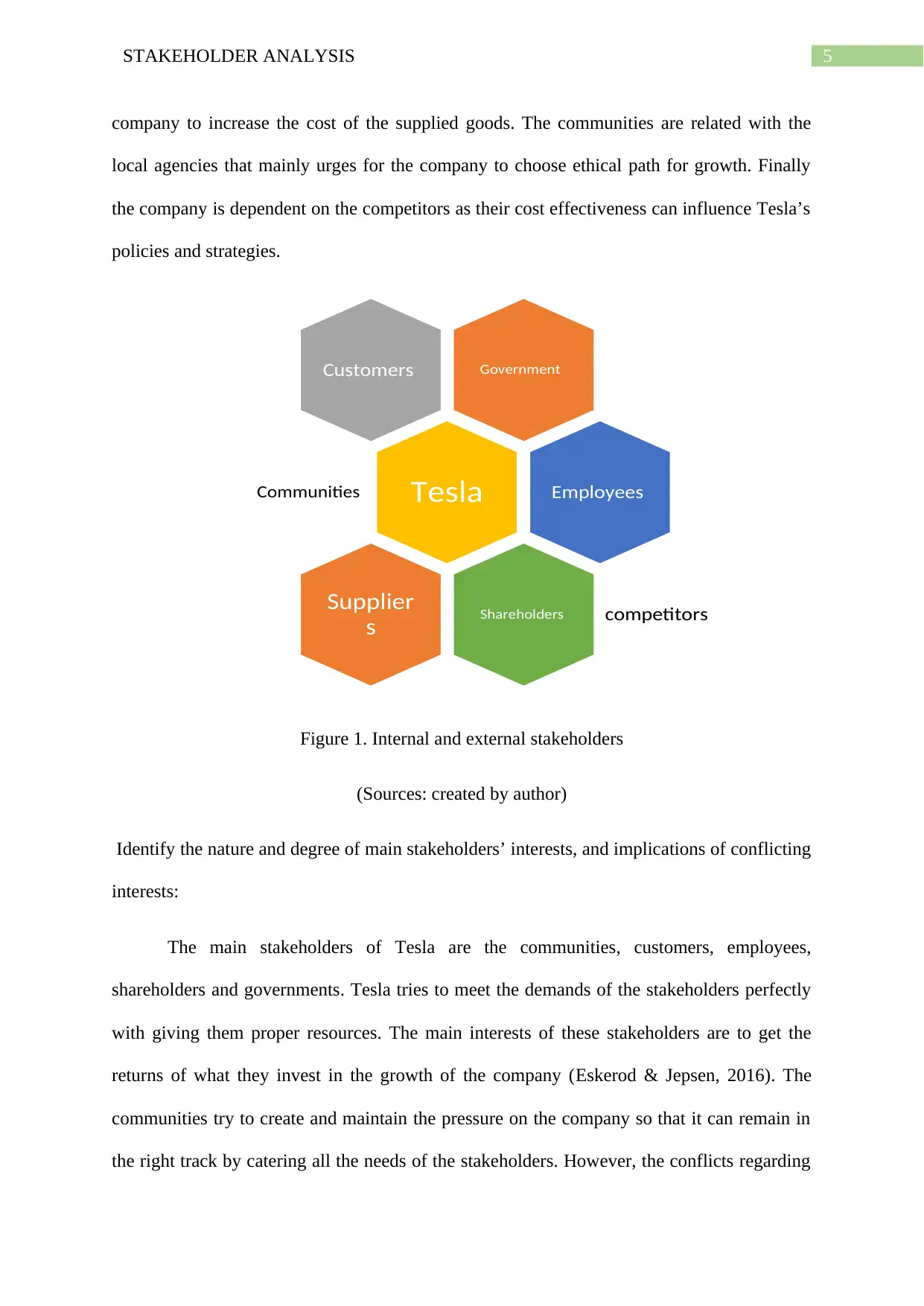
5STAKEHOLDER ANALYSIS
company to increase the cost of the supplied goods. The communities are related with the
local agencies that mainly urges for the company to choose ethical path for growth. Finally
the company is dependent on the competitors as their cost effectiveness can influence Tesla’s
policies and strategies.
Figure 1. Internal and external stakeholders
(Sources: created by author)
Identify the nature and degree of main stakeholders’ interests, and implications of conflicting
interests:
The main stakeholders of Tesla are the communities, customers, employees,
shareholders and governments. Tesla tries to meet the demands of the stakeholders perfectly
with giving them proper resources. The main interests of these stakeholders are to get the
returns of what they invest in the growth of the company (Eskerod & Jepsen, 2016). The
communities try to create and maintain the pressure on the company so that it can remain in
the right track by catering all the needs of the stakeholders. However, the conflicts regarding
GovernmentCustomers
TeslaCommunities Employees
Shareholders competitors
Supplier
s
company to increase the cost of the supplied goods. The communities are related with the
local agencies that mainly urges for the company to choose ethical path for growth. Finally
the company is dependent on the competitors as their cost effectiveness can influence Tesla’s
policies and strategies.
Figure 1. Internal and external stakeholders
(Sources: created by author)
Identify the nature and degree of main stakeholders’ interests, and implications of conflicting
interests:
The main stakeholders of Tesla are the communities, customers, employees,
shareholders and governments. Tesla tries to meet the demands of the stakeholders perfectly
with giving them proper resources. The main interests of these stakeholders are to get the
returns of what they invest in the growth of the company (Eskerod & Jepsen, 2016). The
communities try to create and maintain the pressure on the company so that it can remain in
the right track by catering all the needs of the stakeholders. However, the conflicts regarding
GovernmentCustomers
TeslaCommunities Employees
Shareholders competitors
Supplier
s
⊘ This is a preview!⊘
Do you want full access?
Subscribe today to unlock all pages.

Trusted by 1+ million students worldwide

6STAKEHOLDER ANALYSIS
interests of different stakeholders is common in the company. It is forced to enhance the price
of the cars or other products if suppliers enhance the prices of the raw materials which can
affect the interest of the customer (Cooper, 2017). Similarly, then the demand or expectations
of the customers heightens the company put pressure on the employees for working for long
time or under stress.
Identify the level of main stakeholders’ influence:
The communities in the Tesla Motors heavily influence the policies of the company because
it actually designate the corporate image. The first and foremost concern of these
communities are associated with the environment. Due to the effectiveness of this
stakeholders, the company has effectively addressed the concerns through the development of
the electric cars. The communities are quite satisfied with the ecologically clean as well as
zero emission products. Along with this the company tries to keep the communities satisfied
with the usage of advanced technology because the company allows other parties to use their
technologies so that the growth of technology can the effectively used in the production of
the cars and everyone attains the sustainable growth for the future.
The customers in Tesla are interested in the equality of products and services so that
they get the proper return of their investments. They aim to put pressure on the company to
reduce the prices of the high end cars through the reduction of prices in the batteries and
other parts (Kent & Zunker, 2017). In addition to this, the customers create pressure on the
company through demanding more efficient services for extending the charging stations
networks. Similarly the employees of the company are a crucial headway factor for the
growth of the company. They arête direct impact on the performance and productivity of
Tesla. This is why the company tries to satisfy the concerns through offering competitive
compensations programs and strategies to enrich their professional skills. Along with this the
interests of different stakeholders is common in the company. It is forced to enhance the price
of the cars or other products if suppliers enhance the prices of the raw materials which can
affect the interest of the customer (Cooper, 2017). Similarly, then the demand or expectations
of the customers heightens the company put pressure on the employees for working for long
time or under stress.
Identify the level of main stakeholders’ influence:
The communities in the Tesla Motors heavily influence the policies of the company because
it actually designate the corporate image. The first and foremost concern of these
communities are associated with the environment. Due to the effectiveness of this
stakeholders, the company has effectively addressed the concerns through the development of
the electric cars. The communities are quite satisfied with the ecologically clean as well as
zero emission products. Along with this the company tries to keep the communities satisfied
with the usage of advanced technology because the company allows other parties to use their
technologies so that the growth of technology can the effectively used in the production of
the cars and everyone attains the sustainable growth for the future.
The customers in Tesla are interested in the equality of products and services so that
they get the proper return of their investments. They aim to put pressure on the company to
reduce the prices of the high end cars through the reduction of prices in the batteries and
other parts (Kent & Zunker, 2017). In addition to this, the customers create pressure on the
company through demanding more efficient services for extending the charging stations
networks. Similarly the employees of the company are a crucial headway factor for the
growth of the company. They arête direct impact on the performance and productivity of
Tesla. This is why the company tries to satisfy the concerns through offering competitive
compensations programs and strategies to enrich their professional skills. Along with this the
Paraphrase This Document
Need a fresh take? Get an instant paraphrase of this document with our AI Paraphraser
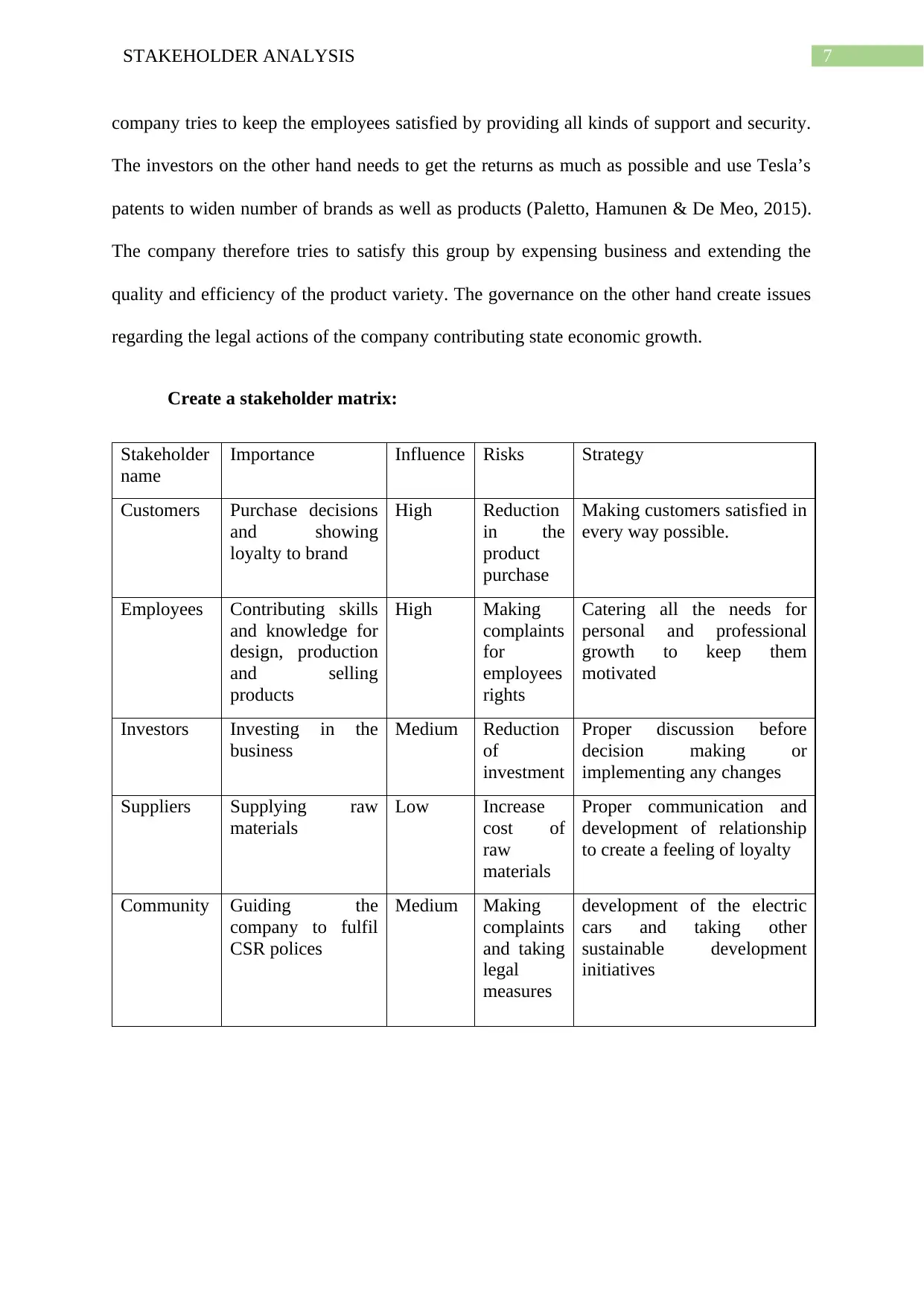
7STAKEHOLDER ANALYSIS
company tries to keep the employees satisfied by providing all kinds of support and security.
The investors on the other hand needs to get the returns as much as possible and use Tesla’s
patents to widen number of brands as well as products (Paletto, Hamunen & De Meo, 2015).
The company therefore tries to satisfy this group by expensing business and extending the
quality and efficiency of the product variety. The governance on the other hand create issues
regarding the legal actions of the company contributing state economic growth.
Create a stakeholder matrix:
Stakeholder
name
Importance Influence Risks Strategy
Customers Purchase decisions
and showing
loyalty to brand
High Reduction
in the
product
purchase
Making customers satisfied in
every way possible.
Employees Contributing skills
and knowledge for
design, production
and selling
products
High Making
complaints
for
employees
rights
Catering all the needs for
personal and professional
growth to keep them
motivated
Investors Investing in the
business
Medium Reduction
of
investment
Proper discussion before
decision making or
implementing any changes
Suppliers Supplying raw
materials
Low Increase
cost of
raw
materials
Proper communication and
development of relationship
to create a feeling of loyalty
Community Guiding the
company to fulfil
CSR polices
Medium Making
complaints
and taking
legal
measures
development of the electric
cars and taking other
sustainable development
initiatives
company tries to keep the employees satisfied by providing all kinds of support and security.
The investors on the other hand needs to get the returns as much as possible and use Tesla’s
patents to widen number of brands as well as products (Paletto, Hamunen & De Meo, 2015).
The company therefore tries to satisfy this group by expensing business and extending the
quality and efficiency of the product variety. The governance on the other hand create issues
regarding the legal actions of the company contributing state economic growth.
Create a stakeholder matrix:
Stakeholder
name
Importance Influence Risks Strategy
Customers Purchase decisions
and showing
loyalty to brand
High Reduction
in the
product
purchase
Making customers satisfied in
every way possible.
Employees Contributing skills
and knowledge for
design, production
and selling
products
High Making
complaints
for
employees
rights
Catering all the needs for
personal and professional
growth to keep them
motivated
Investors Investing in the
business
Medium Reduction
of
investment
Proper discussion before
decision making or
implementing any changes
Suppliers Supplying raw
materials
Low Increase
cost of
raw
materials
Proper communication and
development of relationship
to create a feeling of loyalty
Community Guiding the
company to fulfil
CSR polices
Medium Making
complaints
and taking
legal
measures
development of the electric
cars and taking other
sustainable development
initiatives
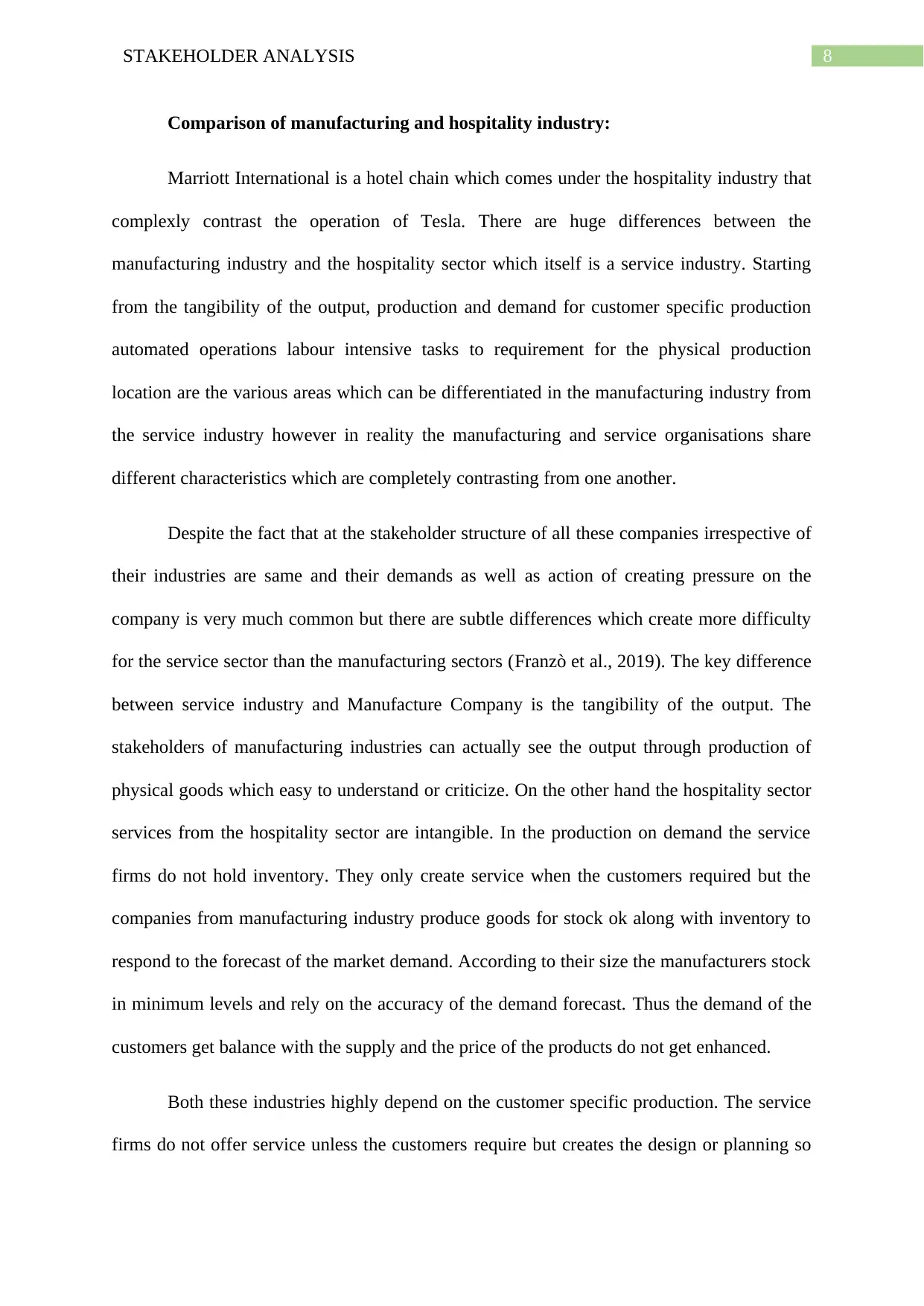
8STAKEHOLDER ANALYSIS
Comparison of manufacturing and hospitality industry:
Marriott International is a hotel chain which comes under the hospitality industry that
complexly contrast the operation of Tesla. There are huge differences between the
manufacturing industry and the hospitality sector which itself is a service industry. Starting
from the tangibility of the output, production and demand for customer specific production
automated operations labour intensive tasks to requirement for the physical production
location are the various areas which can be differentiated in the manufacturing industry from
the service industry however in reality the manufacturing and service organisations share
different characteristics which are completely contrasting from one another.
Despite the fact that at the stakeholder structure of all these companies irrespective of
their industries are same and their demands as well as action of creating pressure on the
company is very much common but there are subtle differences which create more difficulty
for the service sector than the manufacturing sectors (Franzò et al., 2019). The key difference
between service industry and Manufacture Company is the tangibility of the output. The
stakeholders of manufacturing industries can actually see the output through production of
physical goods which easy to understand or criticize. On the other hand the hospitality sector
services from the hospitality sector are intangible. In the production on demand the service
firms do not hold inventory. They only create service when the customers required but the
companies from manufacturing industry produce goods for stock ok along with inventory to
respond to the forecast of the market demand. According to their size the manufacturers stock
in minimum levels and rely on the accuracy of the demand forecast. Thus the demand of the
customers get balance with the supply and the price of the products do not get enhanced.
Both these industries highly depend on the customer specific production. The service
firms do not offer service unless the customers require but creates the design or planning so
Comparison of manufacturing and hospitality industry:
Marriott International is a hotel chain which comes under the hospitality industry that
complexly contrast the operation of Tesla. There are huge differences between the
manufacturing industry and the hospitality sector which itself is a service industry. Starting
from the tangibility of the output, production and demand for customer specific production
automated operations labour intensive tasks to requirement for the physical production
location are the various areas which can be differentiated in the manufacturing industry from
the service industry however in reality the manufacturing and service organisations share
different characteristics which are completely contrasting from one another.
Despite the fact that at the stakeholder structure of all these companies irrespective of
their industries are same and their demands as well as action of creating pressure on the
company is very much common but there are subtle differences which create more difficulty
for the service sector than the manufacturing sectors (Franzò et al., 2019). The key difference
between service industry and Manufacture Company is the tangibility of the output. The
stakeholders of manufacturing industries can actually see the output through production of
physical goods which easy to understand or criticize. On the other hand the hospitality sector
services from the hospitality sector are intangible. In the production on demand the service
firms do not hold inventory. They only create service when the customers required but the
companies from manufacturing industry produce goods for stock ok along with inventory to
respond to the forecast of the market demand. According to their size the manufacturers stock
in minimum levels and rely on the accuracy of the demand forecast. Thus the demand of the
customers get balance with the supply and the price of the products do not get enhanced.
Both these industries highly depend on the customer specific production. The service
firms do not offer service unless the customers require but creates the design or planning so
⊘ This is a preview!⊘
Do you want full access?
Subscribe today to unlock all pages.

Trusted by 1+ million students worldwide
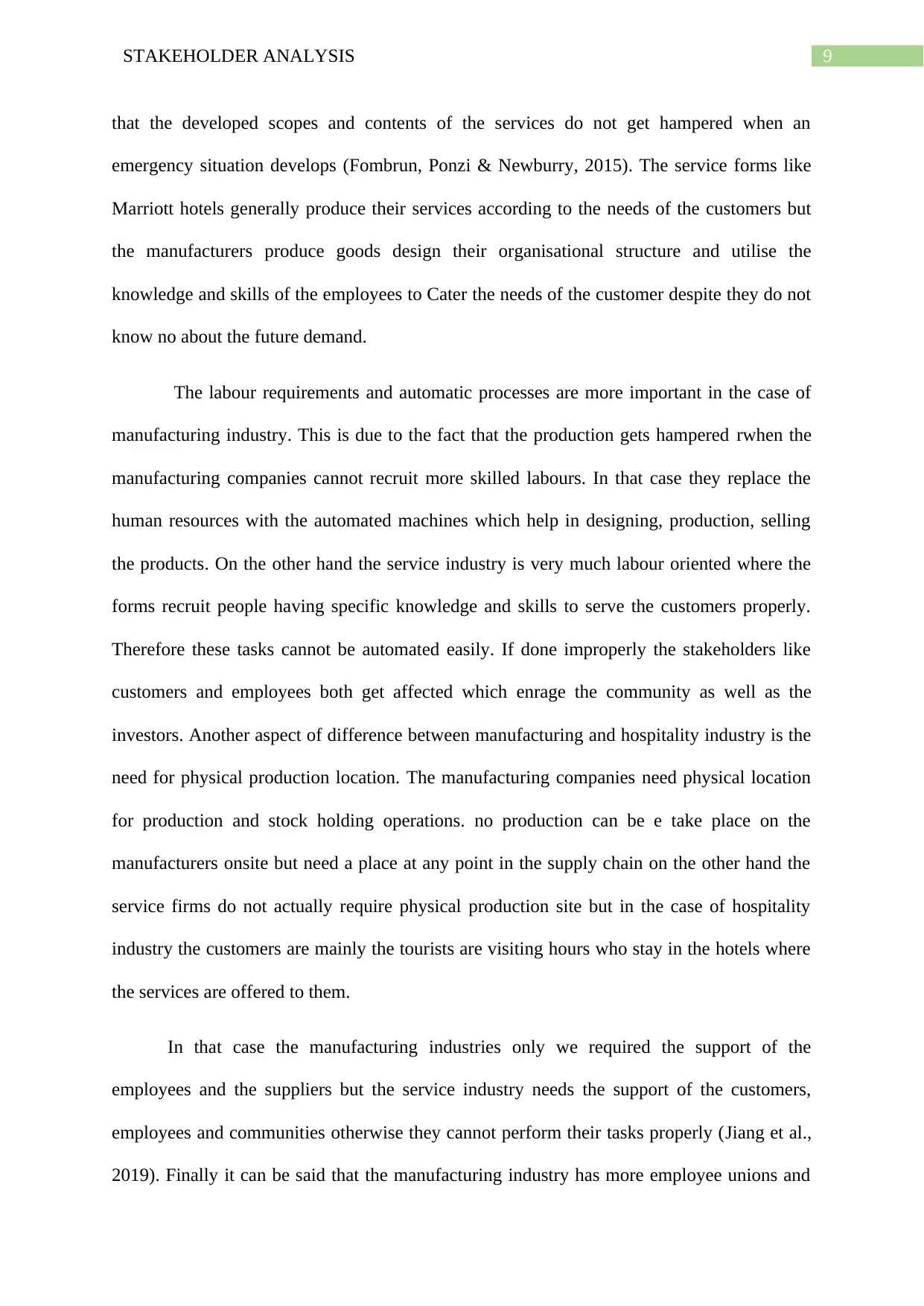
9STAKEHOLDER ANALYSIS
that the developed scopes and contents of the services do not get hampered when an
emergency situation develops (Fombrun, Ponzi & Newburry, 2015). The service forms like
Marriott hotels generally produce their services according to the needs of the customers but
the manufacturers produce goods design their organisational structure and utilise the
knowledge and skills of the employees to Cater the needs of the customer despite they do not
know no about the future demand.
The labour requirements and automatic processes are more important in the case of
manufacturing industry. This is due to the fact that the production gets hampered rwhen the
manufacturing companies cannot recruit more skilled labours. In that case they replace the
human resources with the automated machines which help in designing, production, selling
the products. On the other hand the service industry is very much labour oriented where the
forms recruit people having specific knowledge and skills to serve the customers properly.
Therefore these tasks cannot be automated easily. If done improperly the stakeholders like
customers and employees both get affected which enrage the community as well as the
investors. Another aspect of difference between manufacturing and hospitality industry is the
need for physical production location. The manufacturing companies need physical location
for production and stock holding operations. no production can be e take place on the
manufacturers onsite but need a place at any point in the supply chain on the other hand the
service firms do not actually require physical production site but in the case of hospitality
industry the customers are mainly the tourists are visiting hours who stay in the hotels where
the services are offered to them.
In that case the manufacturing industries only we required the support of the
employees and the suppliers but the service industry needs the support of the customers,
employees and communities otherwise they cannot perform their tasks properly (Jiang et al.,
2019). Finally it can be said that the manufacturing industry has more employee unions and
that the developed scopes and contents of the services do not get hampered when an
emergency situation develops (Fombrun, Ponzi & Newburry, 2015). The service forms like
Marriott hotels generally produce their services according to the needs of the customers but
the manufacturers produce goods design their organisational structure and utilise the
knowledge and skills of the employees to Cater the needs of the customer despite they do not
know no about the future demand.
The labour requirements and automatic processes are more important in the case of
manufacturing industry. This is due to the fact that the production gets hampered rwhen the
manufacturing companies cannot recruit more skilled labours. In that case they replace the
human resources with the automated machines which help in designing, production, selling
the products. On the other hand the service industry is very much labour oriented where the
forms recruit people having specific knowledge and skills to serve the customers properly.
Therefore these tasks cannot be automated easily. If done improperly the stakeholders like
customers and employees both get affected which enrage the community as well as the
investors. Another aspect of difference between manufacturing and hospitality industry is the
need for physical production location. The manufacturing companies need physical location
for production and stock holding operations. no production can be e take place on the
manufacturers onsite but need a place at any point in the supply chain on the other hand the
service firms do not actually require physical production site but in the case of hospitality
industry the customers are mainly the tourists are visiting hours who stay in the hotels where
the services are offered to them.
In that case the manufacturing industries only we required the support of the
employees and the suppliers but the service industry needs the support of the customers,
employees and communities otherwise they cannot perform their tasks properly (Jiang et al.,
2019). Finally it can be said that the manufacturing industry has more employee unions and
Paraphrase This Document
Need a fresh take? Get an instant paraphrase of this document with our AI Paraphraser
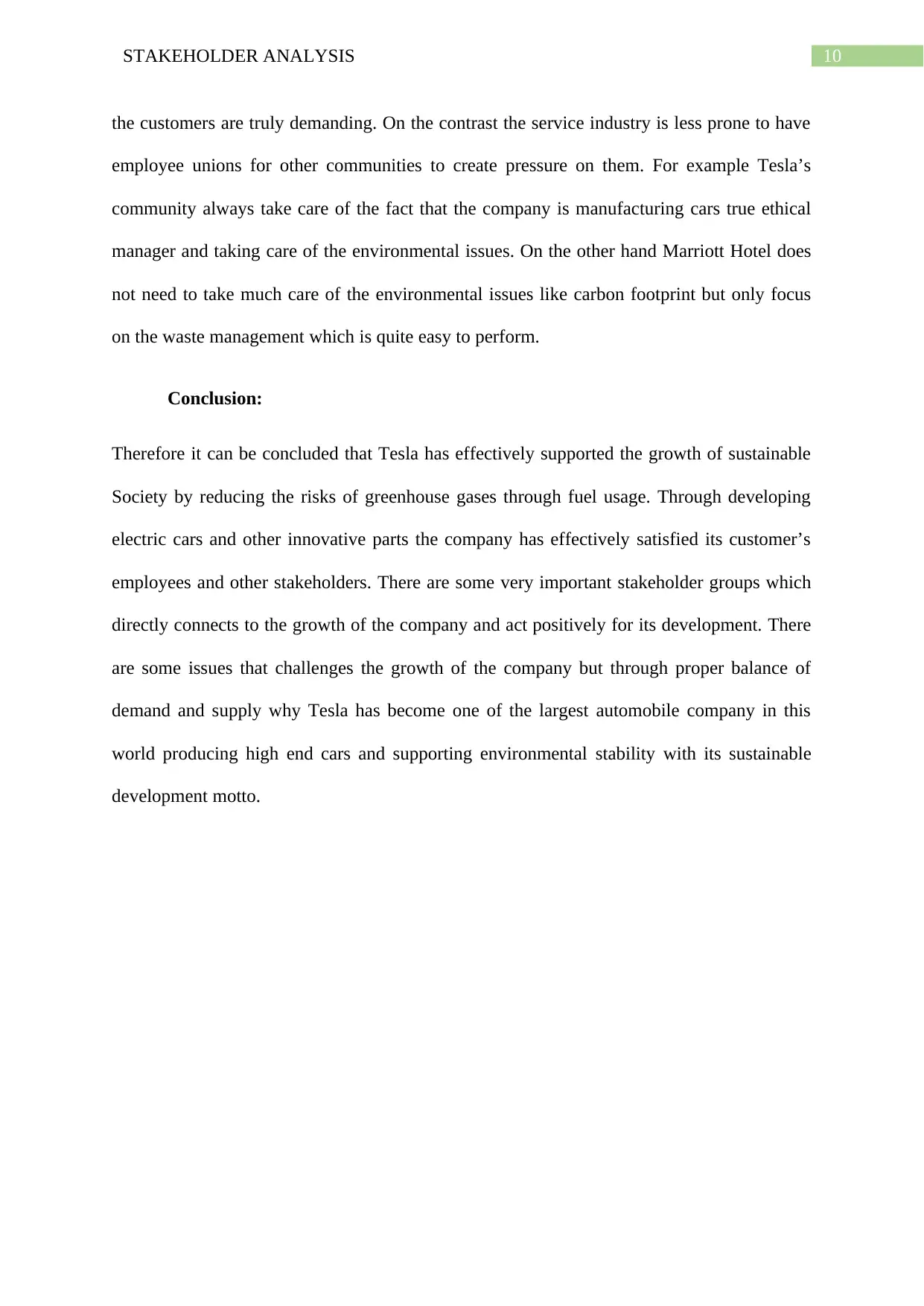
10STAKEHOLDER ANALYSIS
the customers are truly demanding. On the contrast the service industry is less prone to have
employee unions for other communities to create pressure on them. For example Tesla’s
community always take care of the fact that the company is manufacturing cars true ethical
manager and taking care of the environmental issues. On the other hand Marriott Hotel does
not need to take much care of the environmental issues like carbon footprint but only focus
on the waste management which is quite easy to perform.
Conclusion:
Therefore it can be concluded that Tesla has effectively supported the growth of sustainable
Society by reducing the risks of greenhouse gases through fuel usage. Through developing
electric cars and other innovative parts the company has effectively satisfied its customer’s
employees and other stakeholders. There are some very important stakeholder groups which
directly connects to the growth of the company and act positively for its development. There
are some issues that challenges the growth of the company but through proper balance of
demand and supply why Tesla has become one of the largest automobile company in this
world producing high end cars and supporting environmental stability with its sustainable
development motto.
the customers are truly demanding. On the contrast the service industry is less prone to have
employee unions for other communities to create pressure on them. For example Tesla’s
community always take care of the fact that the company is manufacturing cars true ethical
manager and taking care of the environmental issues. On the other hand Marriott Hotel does
not need to take much care of the environmental issues like carbon footprint but only focus
on the waste management which is quite easy to perform.
Conclusion:
Therefore it can be concluded that Tesla has effectively supported the growth of sustainable
Society by reducing the risks of greenhouse gases through fuel usage. Through developing
electric cars and other innovative parts the company has effectively satisfied its customer’s
employees and other stakeholders. There are some very important stakeholder groups which
directly connects to the growth of the company and act positively for its development. There
are some issues that challenges the growth of the company but through proper balance of
demand and supply why Tesla has become one of the largest automobile company in this
world producing high end cars and supporting environmental stability with its sustainable
development motto.

11STAKEHOLDER ANALYSIS
References:
Cooper, S. (2017). Corporate social performance: A stakeholder approach. Routledge.
Eskerod, P., & Jepsen, A. L. (2016). Project stakeholder management. Routledge.
Fombrun, C. J., Ponzi, L. J., & Newburry, W. (2015). Stakeholder tracking and analysis: The
RepTrak® system for measuring corporate reputation. Corporate Reputation
Review, 18(1), 3-24. Retrieved from
https://link.springer.com/article/10.1057/crr.2014.21
Franzò, S., Frattini, F., Cagno, E., & Trianni, A. (2019). A multi-stakeholder analysis of the
economic efficiency of industrial energy efficiency policies: Empirical evidence from
ten years of the Italian White Certificate Scheme. Applied Energy, 240, 424-435.
Retrieved from
https://www.sciencedirect.com/science/article/pii/S0306261919303435
Jiang, W., Wang, A. X., Zhou, K. Z., & Zhang, C. (2019). Stakeholder Relationship
Capability and Firm Innovation: A Contingent Analysis. Journal of Business Ethics,
1-15. Retrieved from https://link.springer.com/article/10.1007/s10551-019-04161-4
Jones, T. M., Wicks, A. C., & Freeman, R. E. (2017). Stakeholder theory: The state of the
art. The Blackwell guide to business ethics, 17-37. Retrieved from
https://onlinelibrary.wiley.com/doi/abs/10.1002/9781405164771.ch1
Kent, P., & Zunker, T. (2017). A stakeholder analysis of employee disclosures in annual
reports. Accounting & Finance, 57(2), 533-563. Retrieved from
https://onlinelibrary.wiley.com/doi/abs/10.1111/acfi.12153
Paletto, A., Hamunen, K., & De Meo, I. (2015). Social network analysis to support
stakeholder analysis in participatory forest planning. Society & natural
References:
Cooper, S. (2017). Corporate social performance: A stakeholder approach. Routledge.
Eskerod, P., & Jepsen, A. L. (2016). Project stakeholder management. Routledge.
Fombrun, C. J., Ponzi, L. J., & Newburry, W. (2015). Stakeholder tracking and analysis: The
RepTrak® system for measuring corporate reputation. Corporate Reputation
Review, 18(1), 3-24. Retrieved from
https://link.springer.com/article/10.1057/crr.2014.21
Franzò, S., Frattini, F., Cagno, E., & Trianni, A. (2019). A multi-stakeholder analysis of the
economic efficiency of industrial energy efficiency policies: Empirical evidence from
ten years of the Italian White Certificate Scheme. Applied Energy, 240, 424-435.
Retrieved from
https://www.sciencedirect.com/science/article/pii/S0306261919303435
Jiang, W., Wang, A. X., Zhou, K. Z., & Zhang, C. (2019). Stakeholder Relationship
Capability and Firm Innovation: A Contingent Analysis. Journal of Business Ethics,
1-15. Retrieved from https://link.springer.com/article/10.1007/s10551-019-04161-4
Jones, T. M., Wicks, A. C., & Freeman, R. E. (2017). Stakeholder theory: The state of the
art. The Blackwell guide to business ethics, 17-37. Retrieved from
https://onlinelibrary.wiley.com/doi/abs/10.1002/9781405164771.ch1
Kent, P., & Zunker, T. (2017). A stakeholder analysis of employee disclosures in annual
reports. Accounting & Finance, 57(2), 533-563. Retrieved from
https://onlinelibrary.wiley.com/doi/abs/10.1111/acfi.12153
Paletto, A., Hamunen, K., & De Meo, I. (2015). Social network analysis to support
stakeholder analysis in participatory forest planning. Society & natural
⊘ This is a preview!⊘
Do you want full access?
Subscribe today to unlock all pages.

Trusted by 1+ million students worldwide
1 out of 13
Related Documents
Your All-in-One AI-Powered Toolkit for Academic Success.
+13062052269
info@desklib.com
Available 24*7 on WhatsApp / Email
![[object Object]](/_next/static/media/star-bottom.7253800d.svg)
Unlock your academic potential
Copyright © 2020–2025 A2Z Services. All Rights Reserved. Developed and managed by ZUCOL.





